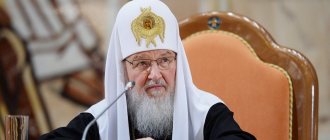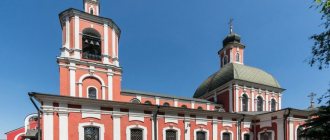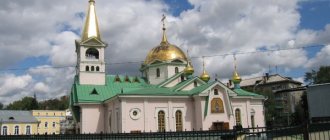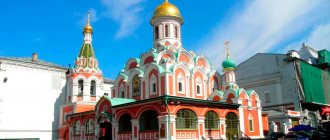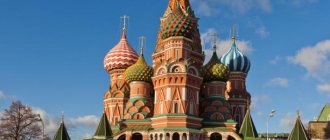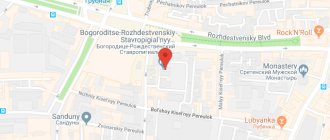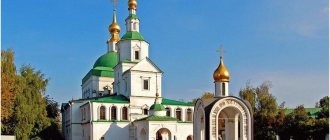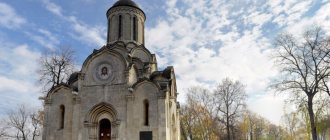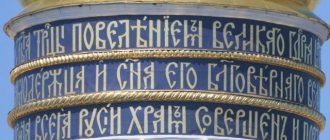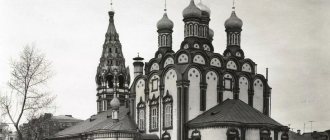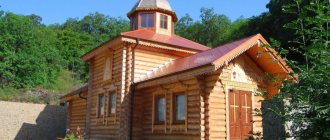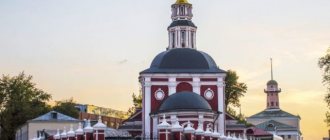History of the temple
In Russia, Orthodox believers had a chance to see a copy of the miraculous icon of the Mother of God, the All-Tsaritsa, the original of which is located in the Athos temple, only in 1995. The community of mercy of the holy righteous John of Kronstadt turned to the abbot of the Vatopedi monastery on Mount Athos, Archimandrite Ephraim, with a request for a copy of the miraculous icon of the All-Tsarina for the children's cancer center. This center constantly houses a large number of young patients and their parents, who should have a chance to directly turn to the image of the Mother of God for healing.
The request received a positive response and blessing that the list of the icon of the All-Tsarina be written in compliance with the church canon, prayer sessions and solemn services.
Thus, a copy of the All-Tsaritsa icon appeared in Moscow, first at the children's oncology center on Kashirskoye Highway, and later moved to the Church of All Saints on Krasnoselsky Lane, where it remains to this day. From time to time, the icon of the All-Tsarina is delivered to the children's oncology center for a service there and the opportunity for everyone to venerate the image and pray.
In 2000, a home church of the Icon of the All-Tsaritsa was created at the clinic of the P. A. Herzen Oncology Institute with the blessing of Patriarch Alexy 2. In 2011, this church was expanded and updated with the blessing of Patriarch Kirill. The church is open to a limited circle of believers: employees, patients of the clinic and institute.
One of the main shrines of the Znamensky Church is the image of the holy martyr Tryphon.
The holy martyr Tryphon was born at the beginning of the 3rd century near the city of Apamea in the Phrygian region. Helping his parents, from early childhood he spent his time in the pasture, where he accustomed himself to the feat of prayer. From a young age, the surrounding residents knew Tryphon as a miraculous healer who cast out demons and healed ailments. The saint was only seventeen years old when, with the help of God, he cast out a demon from the daughter of Emperor Gordian and, at his request, was able to show him the devil in a visible way, in the form of a black dog with fiery eyes, whose head was dragging along the ground. The witnesses to this spectacle were struck with fear and, leaving pagan wickedness, turned to Christ. After the death of Gordian, during the persecution of the emperor Decius, in the year 250, for confessing the True God, Saint Tryphon was subjected to cruel torture and beheaded with a sword.
In Rus', the holy martyr Tryphon has long enjoyed special love. There is a legend that during the reign of Ivan the Terrible, during the royal hunt, the falcon beloved by the sovereign flew away. The Tsar ordered the falconer Trifon Patrikeev to find the flown away bird, threatening him with the death penalty otherwise. Falconer Trifon traveled all over the area, but to no avail. On the third day, tired of a long search, he fell asleep in the forest, having fervently prayed before his patron saint, the martyr Tryphon. In a dream, he saw a young man on a white horse holding the royal falcon in his hand, and this young man said: “Take the missing bird, ride with God to the king and do not be sad about anything.” Waking up, the falconer actually saw a falcon nearby on a pine tree.
In memory of his miraculous salvation, Tryphon Patrikeev built a temple, the main shrine of which was the icon of the holy martyr Tryphon. The appearance of the Moscow version of the image of the martyr Tryphon in the form of a young man on a white horse with a bird in his hands dates back to this time, that is, to the 16th century. For some time, the holy martyr Tryphon was considered the patron saint of Moscow along with the Great Martyr George the Victorious. This is one of the most revered saints in the capital.
The martyr Tryphon is an ambulance in all troubles and needs: he heals physical and mental ailments, protects from unclean spirits, helps to find housing and work, and delivers from sudden troubles and sorrows.
The miraculous image of the holy martyr and wonderworker Tryphon with particles of his venerable relics was brought to the temple in the 1930s by the ever-memorable Archpriest Stefan Markov, along with other shrines from destroyed and closed Moscow churches (Tryphon Church was closed in 1931) and is reverently kept here to this day day. The icon of the martyr Tryphon contains precious reliquaries with particles of his holy relics, sent in 1803 from Montenegro. These reliquaries are a gift from silversmith Trifon Dobryakov.
In honor of the martyr Tryphon, in 1980, an additional altar was consecrated, made from 250-year-old oak by cabinetmaker V.I. Kudinov. The people of the Znamensky Temple are now better known as Trifonovsky.
Every day after the liturgy, before the miraculous image, a water-blessing prayer with an akathist is performed, and on Wednesdays after the evening service, an akathist to the martyr Tryphon is sung in front of a large crowd of people.
On the day of remembrance of the holy martyr and wonderworker Tryphon, February 14, a bishop's service is held in the church.
History of the All-Tsaritsa icon
The main icon of the Mother of God, called the All-Tsarina, or Pantanassa, has been in Greece in the Vatopedi monastery since the 17th century. Located in the cathedral church to the left of the royal gate.
The icon is small in size. It depicts the Blessed Virgin Mary with a baby in her arms. The Mother of God sits on a throne, behind which are located on both sides two angels, reverently overshadowing the Most Pure Virgin with their wings. Baby Jesus is in the arms of the Mother of God, holding a scroll in his left hand, and sending a blessing with his right hand.
According to church traditions, the first miracle from the icon of the All-Tsarina happened in ancient times. The young man, who has no faith and is engaged in witchcraft and magic, which is recognized by the church as a sin, decided to perform a witchcraft ritual in front of the icon of the Mother of God, which was not destined to happen. During his muttering, the face of the Virgin Mary lit up with a bright radiance. This light was filled with unusual power and threw the sinner very far from the icon. The young man was frightened and decided to repent of his actions before the servants of this temple and become a monk in order to serve at the church on Athos.
This event was perceived as a miracle from the holy image, which led the lost soul to repentance and faith. The wonderful events from the All-Tsaritsa icon do not end there. People turning to the image of the Virgin Mary for help in this temple began to testify to miraculous healing from an illness in the form of a malignant and benign tumor.
Cancer is not a new disease of modern times, but a problem that people faced back in the 17th century, but there was no medical treatment as such. The sick turned with prayer to the Mother of God, who was considered the only salvation. Those who prayed sincerely and with all their soul received healing, as evidenced by the entries in the church books of the monastery in Vatopedi on Athos.
Numerous copies of the icon began to be made and sent around the world, so that more people with cancer or their relatives would have hope for healing by turning to the image of the All-Tsarina.
Having appeared in Russia, the icon of the Mother of God to the All-Tsaritsa also showed a miracle. The improvement of children's health in the oncology center in Moscow began to be diagnosed more often with the appearance of the icon, because doctors themselves noted this phenomenon, explaining that drugs cannot provide such a result.
Confirmation that the icon is miraculous is the fact that the image began to flow myrrh on the day of the Nativity of the Blessed Virgin Mary. The temple was filled with fragrance from a few drops. It was again noticed that the icon streams myrrh on the day of the Entry of the Most Holy Theotokos into the temple. Such signs strengthened the spirit of believers and those praying for recovery from cancer and other ailments.
The first liberation of a young man from illness, or more precisely, from drug addiction, is the beginning of miraculous help from the icon of the All-Tsarina in Russia. The good news was passed around Moscow from mouth to mouth and there were more and more people wanting to touch the shrine and pray for their misfortune. It was decided to move the icon to the Church of All Saints and periodically deliver it back to the children's center for worship and spiritual assistance to the sick and their families.
The history of writing copies of the icon of the Mother of God the Tsaritsa for Moscow does not end here. In 1997, the miraculous image of the Mother of God appeared in the Novospassky Monastery. The icon has the same property of streaming myrrh and helping the desperate, those praying with a special sense of faith, to be healed or receive relief from illness.
In the Moscow region there is another list of the All-Tsaritsa - located in the city of Serpukhov in the Vladychny convent. It is recorded that this image streamed myrrh 30 times, which is a real miracle.
What do people pray for to the icon of the Mother of God All-Tsaritsa?
The icon of the Mother of God, the All-Tsarina, both in Moscow and in other churches, is approached by people who themselves or their loved ones are faced with cancer. This icon is revered by Orthodox believers as miraculous specifically in the issue of cancer, which has been known to people since the 17th century, when the tumor was given the name not cancer, but “carcinoma”, translated into Russian as “crab” and “tumor”, which indicates a form of disease that most often resembles a crustacean creature. Hippocrates discovered such a tumor back in 1600 BC, giving it a name and the conclusion that at an early stage it can only be cured by surgery, but at a later stage it is better not to touch it, because there is no cure.
Children, parents, other relatives and friends turn to the icon with prayers. These are sad appeals from parents who believe in recovery until the very end and pray to the Mother of God for strength to overcome this path.
People also turn to the miraculous icon for other illnesses, before operations for which doctors do not give positive prognoses.
In the book of records of miraculous recoveries of people turning to the icon of the All-Tsaritsa, a case is described. After suffering a stroke, a man decided to check his well-being and underwent an MRI examination. The diagnosis shocked him, because after overcoming a stroke, he learned about brain oncology. Surgery was required. The patient decided to visit the Church of the Icon of the Mother of God the Tsaritsa for a blessing for a serious step. He was accompanied by his wife, who ordered a prayer service to the image of the Virgin Mary with the blessing of water, which the man took with him to the hospital. The saint’s daily prayers and drinking water gave a positive result - during the preoperative MRI examination, the tumor was not detected, which became a fact of miraculous healings of believers and sincerely praying Christians.
There are a lot of similar cases. They become known from the people themselves, who returned again to the All-Tsaritsa to thank her for her help.
Church of the Assumption of the Blessed Virgin Mary on Pokrovka (in Kotelniki)
This was Dostoevsky’s favorite Moscow church - when he was in Moscow, he always went there to pray. And Academician Likhachev wrote: “In my youth, I came to Moscow for the first time, and accidentally came across the Church of the Assumption on Pokrovka. I didn't know anything about her before. Meeting her stunned me. A frozen cloud of white and red lace rose in front of me... It all seemed to be the embodiment of an unknown idea, a dream of something incredibly beautiful. It cannot be imagined from surviving photographs and drawings; it had to be seen surrounded by low, ordinary buildings.”
Assumption Church. Lithograph from 1825
Built at the very end of the 17th century at the expense of the Moscow merchant Sverchkov by the architect Potapov, the temple was truly one of the brightest monuments of the Moscow, “Naryshkin” baroque. Architect Bazhenov considered the Assumption Church one of the most beautiful buildings in Moscow, and the author of the Winter Palace, Francesco Rastrelli, said that it was she who inspired him to create the Smolny Cathedral in St. Petersburg.
Even Napoleon, when he entered Moscow, was so impressed by the architecture of the Assumption Church that, according to one version, he ordered a special guard to be placed to protect it from looters and fire - by the way, it actually did not suffer from the fire of 1812, which destroyed most of Moscow.
After the revolution, People's Commissar of Education Lunacharsky used all his authority to preserve this temple. But in 1933, the People's Commissar died, and in November 1935, the Moscow Soviet adopted a resolution to demolish the church “due to the urgent need to expand the passage along the street. Pokrovka". Restoration architects tried to protect the temple, but they failed to defend it, and in the winter of 1936 it was demolished.
For a long time there was a beer hall in its place, then a summer cafe. And now there is a park.
But something from the Assumption Church still remains: two carved platbands and a portal are embedded in the fence of the Donskoy Monastery - under Soviet rule there was a branch of the Shchusev Museum of Architecture; Even before the demolition of the temple, the iconostasis was moved to the Novodevichy Convent, several icons ended up in the State Historical Museum, and in 2004, during the renovation of the clergy house, a large well-preserved fragment of the wall of the Assumption Church was found.
How to get to the Church of the Icon of the Mother of God Vsetsaritsa
You can get to the temple in Moscow, where the miraculous icon is located, in different ways, knowing the address of the temple or monastery, because there is more than one list of the Athos icon. It is better to check what kind of transport to get to the monastery or temple on the official website:
- The Church of All Saints is located on Krasnoselsky Lane. The landmark for nonresident believers is the Krasnoselskaya metro station. A route for a personal car or traveling by public transport can be built by studying a map of the city of Moscow in the area of this station.
- Novospassky Monastery - this church is located in Moscow on Krestyanskaya Square, building 10. The landmark for the area is the Proletarskaya metro station.
- Vvedensky Vladychny Convent is located in the city of Serpukhov, Moscow region, 2-Narsky Lane.
- At the oncology center for children, located on Kashirskoe Highway, patients and their relatives can pray on the day when the icon is delivered for prayer from the Church of All Saints.
To visit the chosen church, you need to check in advance the opening hours of churches and monasteries and the schedule of services, if you want not only to light a candle and pray, but also to defend the service, order a prayer service.
Church of the Resurrection of the Word on Ostozhenka
On March 21, 1925, His Holiness Patriarch Tikhon served in the Church of the Resurrection of the Word, a few days before his death.
This church was first mentioned in documents in 1625. However, it could have existed here in the 14th century - some services and sacraments (for example, weddings) are not performed in monastery churches, so they built assigned “religious” churches at the monasteries. At the Conception Monastery there was such a church in honor of the feast of the Renewal (consecration) of the Church of the Resurrection of Christ in Jerusalem, or simply the Resurrection of the Word on Ostozhenka.
Church of the Resurrection of the Word on Ostozhenka. 1882
By the end of the 18th century, it had become so dilapidated, and there were so many parishioners, that in 1800 they began to build a new refectory with two chapels and a bell tower in the classicist style. But in 1812, the temple was badly damaged by fire, and the French plundered it pretty much - it had to be restored. And finally, by 1831, the Church of the Resurrection had a new bell tower with a spire, a refectory and chapels of the Martyr Barbara and the Intercession of the Most Holy Theotokos. And in 1853, the future philosopher Vladimir Solovyov was baptized in this church.
In 1917, the temple found itself at the epicenter of street battles: in early November, the Bolsheviks set up a firing point on its bell tower, from which they fired at the headquarters of the Moscow Military District.
And in 1933, the Church of the Resurrection was closed. One of the last in the area. And in 1935 it was completely demolished - “in connection with the start of construction work on the Usachevsky radius of the metro,” and its community moved to the neighboring Church of Elijah the Prophet in Obydensky Lane.
But there was also a graveyard next to the church - it was first mentioned in 1657. In 2022, during archaeological research, human remains and several gravestones were discovered.
Now on the site of the Resurrection Church - where the 1st and 2nd Zachatievsky lanes depart from Ostozhenka to the Conception Monastery - there is a square. But archival and historical materials are being collected to restore the temple.
